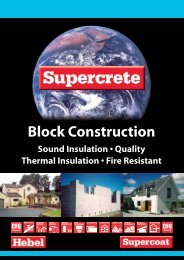Structural Floor Panels Design Guide - Hebel Supercrete AAC ...
Structural Floor Panels Design Guide - Hebel Supercrete AAC ...
Structural Floor Panels Design Guide - Hebel Supercrete AAC ...
You also want an ePaper? Increase the reach of your titles
YUMPU automatically turns print PDFs into web optimized ePapers that Google loves.
1.2 Thermal Insulation<br />
1.2.1 Inter-Storey Thermal Efficiency<br />
Heat loss and gain through floors can contribute greatly<br />
to the energy requirements of a building. Whilst only<br />
about 10% of a room’s heat energy goes down through<br />
a floor, approximately 42% of it goes up into the room<br />
above. Having an efficient insulator between storeys greatly<br />
improves the overall performance of a multi storey building,<br />
especially the lower floors.<br />
42%<br />
48% 48%<br />
10%<br />
Approximate Distribution distribution of of heat heat transfer transfer through<br />
the shell of through a typical the shell home. of a typical home<br />
Note: Percentages can vary depending on insulation,<br />
Note: Percentages can vary depending on insulation, area and<br />
area and type of glazing etc.<br />
type of glazing etc.<br />
<strong>Supercrete</strong> <strong>Structural</strong> <strong>Floor</strong> <strong>Panels</strong> provide superior<br />
levels of comfort, compared to conventional dense<br />
concrete suspended slab floors. The cellular, aerated nature<br />
of <strong>Supercrete</strong> <strong>Structural</strong> <strong>Floor</strong> <strong>Panels</strong> provides high<br />
levels of thermal insulation, which is useful for containing<br />
airborne convective heat in winter and blocking it out in<br />
summer. Radiant heat is similarly contained. Under carpet<br />
or tile heating mats benefit from being positioned on the<br />
surface of <strong>Supercrete</strong> <strong>Structural</strong> <strong>Floor</strong> <strong>Panels</strong>, as these<br />
panels greatly reduce heat loss into sub-floor spaces. Piped<br />
underfloor heating systems can be bedded into a topping<br />
screed (See Detail SFP 4-1, page 49).<br />
<strong>Supercrete</strong> floors provide greater comfort<br />
and thermal performance than traditional<br />
concrete floors.<br />
1.2.2 R-Value Calculation<br />
Insulation is measured by the resistance to heat transfer<br />
from one side of an object to the opposite side.<br />
The resistance is known as an R-Value and uses the<br />
measurements M2/KW. A floor made from 150mm dense concrete would have<br />
an R-Value of around 0.10 compared with <strong>Supercrete</strong><br />
<strong>Structural</strong> <strong>Floor</strong> <strong>Panels</strong> of the same thickness having<br />
an R-Value of 1.03, or approximately ten times better<br />
insulation than dense concrete.<br />
A typical thermal calculation for a floor/ceiling assembly is<br />
shown below.<br />
Table 1. R-Value Calculation<br />
Top Surface Air Film = R 0.11<br />
Carpet = R 0.17<br />
Rubber Underlay = R 0.17<br />
150mm <strong>Floor</strong> Panel (5% moisture) = R 0.85<br />
Ceiling Cavity Airspace (non-reflective) = R 0.15<br />
50mm Insulation = R 1.80<br />
12mm Plasterboard Ceiling = R 0.05<br />
Ceiling Surface Air Film (reflective) = R 0.23<br />
TOTAL = R 3.53<br />
Various floor assembly thermal and acoustic<br />
performances are shown in Tables 2-8, pages 10-13.<br />
1.3 Acoustic Performance<br />
The field of acoustics is too broad to cover in depth in<br />
these notes, however this section provides a brief overview<br />
of the concepts of acoustic insulation.<br />
Building noise can be broken into two basic categories,<br />
Airborne noise and Impact noise. The following<br />
sections detail how the <strong>Supercrete</strong> <strong>Structural</strong> <strong>Floor</strong> Panel<br />
System deals with both types of noise.<br />
What we hear as sound is actually small pressure<br />
fluctuations in the air causing movement of the tiny bones<br />
and membranes within our ear. Airborne noise is caused<br />
by emitters of sound, such as stereos, TVs, human speech,<br />
machinery, etc. These emitters of sound vibrate the air<br />
around them and the radiating pressure ripples in the air<br />
reach our ears, where we receive and identify the sound.<br />
Impact noise is also heard because of air pressure<br />
fluctuations, but this noise is caused by the direct impact or<br />
force acting on an object, which causes vibration of both<br />
the impacted item and the air around it, such as footsteps<br />
on a floor surface, tapping on a wall, etc.<br />
SFP 2012 8 Copyright © <strong>Supercrete</strong> Limited 2008



